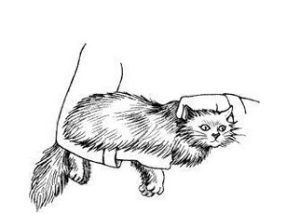HIT BY A CAR
The first thing to do if you find your cat hit by a car is to try to remain calm. This isn’t easy, since your animal is so important to you, but hysterics will not help you or your cat. Try to assess the damage that has been done.
You must gather information to help your veterinarian decide on the seriousness of the injuries before you get to the hospital. So concentrate your attention on this plan of action while administering first aid.
Many seriously injured animals try to run from the scene of the accident in fright, thereby increasing their injuries or becoming lost and unavailable for veterinary care. Do not leave your cat unattended for one second. If necessary ask a bystander to telephone your veterinarian, or carry your animal with you to the telephone. (But before moving any injured cat check for possible fractures or spinal cord damage. See below.)
EVALUATE VITAL SIGNS
First, evaluate your cat’s vital signs. Look for signs of shock, consciousness, airway obstruction, breathing, and heartbeat. If the airway is obstructed, the cat is not breathing or seems unconscious, and you cannot detect a heartbeat, cardiopulmonary resuscitation (CPR) may be needed. A fracture or large cut can be spectacular and frightening, but this matter takes secondary consideration. If signs of shock are present, be sure your cat gets professional veterinary care at once. If this is not possible and shock is present, indicating the possibility of internal bleeding, an elastic bandage wrapped firmly around the abdomen can be effective in raising blood pressure and limiting blood loss until veterinary aid can be obtained. Be sure any wrap you apply is firm but does not further compromise the breathing.
EXTERNAL AND INTERNAL BLEEDING
Even a small amount of blood can make a wound appear to be more serious than it is. Try to determine the source of the blood loss. When you find the site, you will often find that the bleeding has stopped.
If there is a great deal of bleeding from the wound, apply a makeshift pressure bandage or direct pressure to it. Persistent bleeding from the nose and/or mouth requires immediate veterinary care, as does blood in the urine or signs that indicate internal bleeding and/or injury (shock, abdominal pain, difficulty breathing).
BROKEN BONES
A veterinarian should be consulted if you think your cat has a fractured limb, but the fracture itself may not be an emergency if the cat is doing well otherwise. Paralysis or partial paralysis may indicate spinal cord damage and requires that you keep the vertebral column as immobile as possible from the time of the accident until you arrive at the veterinary hospital. A small box or cat carrier is the best means to carry a severely injured cat. If you can’t determine the extent of the injury or do not have a makeshift carrier available, try carrying the cat as illustrated.
CARRYING AN INJURED CAT
INTERNAL INJURIES
If you find that your cat seems essentially normal following an accident, you may not need to see a veterinarian. You should be aware, however, that certain major internal injuries may not be apparent for several hours (sometimes days) following such trauma, for example, diaphragmatic hernia.
DIAPHRAGMATIC HERNIA
A diaphragmatic hernia results when a tear in the diaphragm allows the abdominal organs to move through it into the chest. If the tear occurs at the time of an accident but the actual hernia does not (or is mild), you may not see any signs. When the abdominal organs herniate (or a small hernia gets worse), strained respiration ensues. Lack of appetite, difficulty swallowing, or vomiting may be seen. If you try to hear the heart sounds, they may be absent or muffled. If a large portion of the abdominal organs have moved into the chest, you may notice a “tucked up” abdomen. Watch for signs indicating possible diaphragmatic hernia for several weeks following any severe accident.
Be sure to watch for signs of normal urination following incidents involving abdominal trauma, such as that suffered when a cat is hit by a car. Cats with ruptured bladders may act normal at first, then later develop abdominal pain or their abdomens may be very tender when first examined. If urination is completely absent, or urine is blood-stained, or if normal-looking urine is passed with some difficulty, suspect a ruptured bladder, which is a surgical emergency.
If your cat is not examined by a veterinarian following an accident be sure to perform a thorough physical examination yourself, and watch your cat closely for signs of shock for twenty-four hours (keep the animal
indoors). Don’t forget to examine the abdomen thoroughly by palpation. If your cat shows signs of pain such as tensing (contracting) the abdominal muscles more than usual or crying out, or if the abdomen feels unusual to you (too few, too many, or unusually shaped masses present), be sure to arrange for an examination by a veterinarian.
